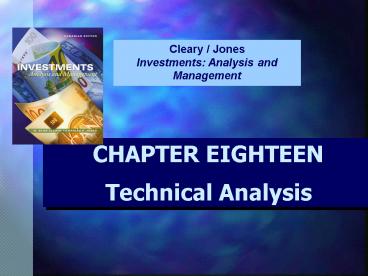BusAd 551 Corporate Financial Decisions - PowerPoint PPT Presentation
1 / 19
Title:
BusAd 551 Corporate Financial Decisions
Description:
Use of published market data for analysis of both aggregate stock prices and individual stocks ... buy calls (puts) when stock prices expected to rise (fall) ... – PowerPoint PPT presentation
Number of Views:71
Avg rating:3.0/5.0
Title: BusAd 551 Corporate Financial Decisions
1
Cleary / Jones Investments Analysis and
Management
CHAPTER EIGHTEEN Technical Analysis
2
Learning Objectives
- To define technical analysis and explain why it
is used - To describe the major techniques used in
technical analysis - To discuss the limitations of technical analysis
3
What is Technical Analysis?
- Use of published market data for analysis of both
aggregate stock prices and individual stocks - May produce insight into the psychological
dimensions of the market - Used by investors and investment advisory firms
- Oldest approach to stock selection
4
Technical Approach
- Prices move in trends determined by changing
attitudes of investors - Identify change in trend at an early stage and
maintain investment posture until evidence
indicates otherwise - Market itself is the best source of data about
trends - Data includes prices, volume, and technical
indicators
5
Technical Approach
- Technicians disagree with fundamental analysis
because they believe it is extremely difficult to
estimate intrinsic value and to obtain and
analyze information consistently - Technicians believe market data indicates forces
of demand and supply - Record of investor mood that can be detected and
is likely to continue
6
Tools For Technical Analysis
- Use of graphs, charts, and technical trading
rules and indicators - Price and volume are primary tools of the pure
technical analyst - Technicians use charts to identify trends and
patterns in stock prices that provide trading
signals - Volume data used to gauge market condition and to
assess its trend
7
The Dow Theory
- Based on three types of price movements
- Primary move a broad market movement that lasts
several years - Secondary moves occurring within primary move,
lasting several weeks or months - Day-to-day moves occurring randomly around
primary and secondary moves - Bull (bear) market refers to upward (downward)
primary move
8
The Dow Theory
- Bull market occurs when successive rallies
penetrate previous highs - Declines remain above previous lows
- Bear market occurs when successive rallies fail
to penetrate previous highs - Declines penetrate previous lows
- Secondary moves called technical corrections
- Day-to-day ripples are of minor importance
9
Charting Price Patterns
- Price changes can be recognized and categorized
- Support price level significant increase in
demand is expected - Resistance price level significant increase in
supply is expected - Trendline identifies a trend or direction
- Momentum speed of price changes
10
Charting Price Patterns
- Bar Chart
- Vertical bars top (bottom) represents the high
(low) price of the day - Point-and-Figure Chart
- Compresses price changes into small space
- Areas of congestion identified
- X (O) used to indicate significant upward
(downward) movement
11
Moving Averages
- Used for analyzing both the overall market and
individual stocks - Used specifically to detect both the direction
and rate of change - New value for moving average calculated by
dropping earliest observation and adding latest
observation to the average - Comparison to current market prices produces buy
or sell signal
12
Relative Strength
- Ratio of a stocks price to a market or industry
index - Ratios plotted to form graph of relative price
across time - Rising (falling) ratio indicates relative
strength (weakness) - What if overall market is weak?
- What if a stock is declining less quickly than
the market?
13
Breadth Indicators
- Advance-Decline Line
- Measures the net difference between number of
stocks advancing and declining - Plot of running total across time is compared to
a stock average to analyze any divergence - Divergence implies trend changing
- Number hitting new highs (lows)
- High trading volume regarded as bullish
14
Sentiment Indicators
- Short interest is number of stocks that have been
sold short - Short interest ratio
- Total shares sold short/Average daily trading
volume - Indicates number of days needed to work off the
short interest - Many technicians take a high short interest ratio
as a bullish sign - Short interest figures may be distorted
15
Mutual Fund Liquidity
- Based on contrary opinion
- Mutual funds, viewed like odd-lotters, assumed to
act incorrectly before a market turning point - Low liquidity implies funds fully invested
(bullish) and market is near or at peak - High liquidity implies funds are bearish
- Considered a good time to buy
16
Put/Call Ratio
- Speculators buy calls (puts) when stock prices
expected to rise (fall) - Rise (fall) in ratio of put option purchases to
call option purchases indicates pessimism
(optimism) - Buy (sell) signal to a contrarian
- Extreme readings (below .7 or above .9) convey
trading information
17
Testing Technical Analysis Strategies
- What constitutes a fair test of a technical
trading rule? - Risk considerations
- Include transaction and other costs
- Consistency in performance
- Out-of-sample validation
- Filter rule tests
- Trades made when price change greater than
predetermined filter
18
Conclusions About Technical Analysis
- Thorough tests of technical analysis have failed
to confirm their value, given all trading costs
and the alternatives, such as a buy-and-hold
strategy - Several interpretations of each technical tool
and chart pattern are not only possible, but
usual - Art or science?
19
Conclusions About Technical Analysis
- Strong evidence exists suggesting that stock
price changes are weak-form efficient - Impossible to test all techniques of technical
analysis - Regardless of evidence, technical analysis
remains popular with many investors































